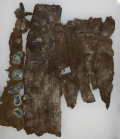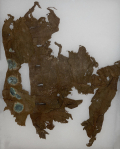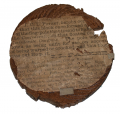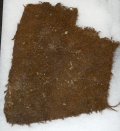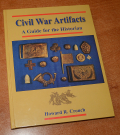site search
online catalog
Relics
Showing 81 to 100 out of 343
PIECE OF AN INDIAN WAR M1872 FATIGUE BLOUSE FROM FORT PEMBINA, ND
This is a portion of a rare Model 1872 fatigue blouse clearly showing the characteristic pleats of the pattern. These were replacements for the old Civil War M1858 fatigue blouse (the 4-button sack… (1052-579). Learn More »
PIECE OF AN INDIAN WAR M1872 FATIGUE BLOUSE FROM FORT PEMBINA, ND
This is a portion of the rare Model 1872 fatigue blouse. The pattern was a replacement for the old Civil War M1858 fatigue blouse (the 4-button sack coat,) made with the idea of giving the soldier… (1052-578). Learn More »
KEPI OR DRESS CAP STIFFENER FROM FORT PEMBINA
This comes from the excavations at Fort Pembina, ND, a small frontier army post in operation from 1870 to 1895, and is the stiffener from inside the top of a kepi a M1872 dress cap. It is black in… (1052-1152). Learn More »
KEPI OR DRESS CAP STIFFENER FROM FORT PEMBINA
This comes from the excavations at Fort Pembina, ND, a small frontier army post in operation from 1870 to 1895, and is the stiffener from inside the top of a kepi a M1872 dress cap. It is black in… (1052-475). Learn More »
ANDREW GREGG TUCKER POST 52 G.A.R. PLINTH, LEWISBURG, PA, HONORING THE 142nd PA OFFICER KILLED AT GETTSYBURG, WITH A BATTLEFIELD PICKUP BAYONET
This “Black Granite” plinth is painted in gold with the name of the G.A.R. post in which it was used, along with the donor’s name, and the date and location where that post’s officer … (2024-1366). Learn More »
GETTYSBURG MICHIGAN CAVALRY BRIGADE SPENCER RIFLE: SECOND DELIVERY “COPELAND” SPENCER, SERIAL #1811 WITH CONFEDERATE “Q” CLEANED AND REPAIRED STAMP
M1860 Spencer Army Rifles are highly sought after and one falling in the serial number range for issue in Custer’s Michigan Cavalry Brigade before Gettysburg is a holy grail for many. This one has… (172-6073). Learn More »
PIECE OF A U.S. FLAG FROM THE FRONTIER US ARMY FORT PEMBINA, NORTH DAKOTA
This piece of bunting comes from excavations at Fort Pembina, ND, conducted on private property with the owner’s permission, a fort established in 1870 by troops of the 20th US Infantry and… (1052-722). Learn More »
PIECE OF CIVIL WAR - INDIAN WAR FRONTIER US ARMY BLANKET FROM FORT PEMBINA, NORTH DAKOTA
This piece of a US Army military issue blanket comes from excavations at Fort Pembina, ND, conducted on private property with the owner’s permission, a fort established in 1870 by troops of the 20th… (1052-615). Learn More »
US ARMY SHIRT CUFF FROM FORT PEMBINA, NORTH DAKOTA
A relic from a small U.S. Army frontier post of the Indian Wars- part of a soldier’s shirt. This is the shirt cuff, still showing a small button near the corner, and a portion of the lower sleeve.… (1052-602). Learn More »
REMNANT OF SCARCE INDIAN WAR SOLDIER’S MITTEN FROM FORT PEMBINA, ND
This comes from the excavations at Fort Pembina, occupied 1870-1895, where cold weather in winter months might well be a concern. The army began issuing mittens in 1873. Before that men were left to… (1052-584). Learn More »
SLICE OF CONFEDERATE FLAG POLE FROM RICHMOND
Here is a 3/8” thick slice of wood that measures 4 ¼” in diameter. Glued to one side is the remains of an old, printed label: “Richmond, Va., May 20, 1890. I, C.L. Parker, hereby cer[tify] that… (1030-324). Learn More »
$625.00
Originally $780.00
KEPI CHINSTRAP AND SIDE BUTTONS FROM AN INDIAN WAR FRONTIER
This is a complete leather chinstrap from an army kepi or forage cap from excavations at Fort Pembina, ND. The chinstrap is a two-piece style with a fixed loop on the end of one strap and a fixed… (1052-486). Learn More »
CIVIL WAR-INDIAN WAR UNIFORM COAT PIECE WITH BUTTON FROM FORT PEMBINA
This is part of the right lapel of a US army coat discarded by a soldier at Fort Pembina, ND, sometime between 1870 and 1895, and is from excavations in wet, anaerobic soil that has preserved leather… (1052-724). Learn More »
PIECE OF US ARMY BLANKET FROM FORT PEMBINA, NORTH DAKOTA
This piece of a US Army military issue blanket comes from excavations at Fort Pembina, ND, conducted on private property with the owner’s permission, a fort established in 1870 by troops of the 20th… (1052-616). Learn More »
“EXCAVATED ARTIFACTS” BY STANLEY PHILLIPS
Full title of this hardcover volume is “EXCAVATED ARTIFACTS FROM BATTLEFIELDS AND CAMPSITES OF THE CIVIL WAR 1861-1865” by Stanley S. Phillips. Volume measures 8.5” x 11” and runs 220 pages… (1266-1053). Learn More »
EXCAVATED MODEL 1855 SOCKET BAYONET MADE INTO POT HOOK
This is a M-1855 socket bayonet in very good, “dug” condition. Bayonet has been cleaned and coated and the iron is in very stable condition. The tip has been broken off and the next 2 ½”… (1000-1380). Learn More »
$360.00
Originally $450.00
RARE CONFEDERATE “THREE SQUARE” SOCKET BAYONET MADE INTO POT HOOK
This is an excavated example of a Confederate-made musket socket bayonet. Measuring approximately 21” overall with a 2 ¾” socket. This was made for an early .69 caliber musket with a bayonet… (1000-1374). Learn More »
$715.00
Originally $895.00
BOOK – CIVIL WAR ARTIFACTS, A GUIDE FOR THE HISTORIAN BY CROUCH
A classic “relic book” by Howard R. Crouch. Printed hardcover, 8.5” x 11”, 238 pages. Very good condition from the library of William Turner. The pages are filled with photographs of great… (1266-1086). Learn More »
EXCAVATED CIVIL WAR “VMM” OVAL WAIST BELT PLATE
Presented here is an excavated “Volunteer Militia of Maine” oval waist belt plate that was issued to the State’s volunteer infantrymen early in the Civil War. Maine formally organized its… (1000-1541). Learn More »
$1,480.00
Originally $1,850.00
DUG CIVIL WAR ID DISK FOR 12TH PENNSYLVANIA RESERVES (41st PENNSYLVANIA) SOLDIER
Front of the tag has a bust of General McClellan surrounded by “MAJOR GENERAL GEO. B. MCCLELLAN / WAR OF 1861.” Face is dark with gilt remaining in the low areas. Reverse is stamped “DANIEL… (1000-1836). Learn More »
$1,800.00
Originally $2,250.00
Showing 81 to 100 out of 343
Most Popular
Historical Firearms Stolen From The National Civil War Museum In Harrisburg, Pa »
Theft From Gravesite Of Gen. John Reynolds »
Selection Of Unframed Prints By Don Troiani »
Fine Condition Brass Infantry Bugle Insignia »
Large English Bowie Knife With Sheath 1870’S – 1880’S »
Imported (Clauberg) Us Model 1860 Light Cavalry Officer's Saber »
featured item
US MARINE CORPS OFFICER’S ENGLISH MADE MAMALUKE WITH IVORY GRIP
Manufactured: England Maker: Unmarked Year: C1820-25 Model: Mamaluke Size: 35.8 inch blade, 1.21 wide Condition: Excellent+ Tri-color blade - blue, gold and "white" of flat design. Ship's Mast, American Eagle, Standing Indian figure and… (870-76). Learn More »



